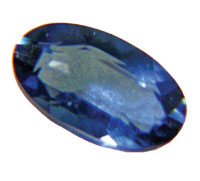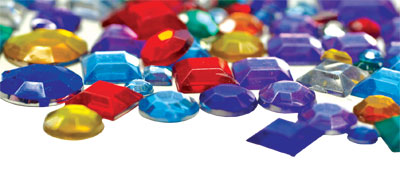Gems - cosy symbiosis of Sri Lankan culture
by Amal Hewavissenti
These very attractive and valuable precious stones snugly ensconced
in Sri Lankan soil offer a reasonable ground for Sri Lanka to have an
unrivalled reputation in Asia and European countries.

Apart from profusely scattered references in literature to valuable
stones in history, accounts of ancient travellers, and foreigners
provide a vivid picture of the cosy symbiosis of Sri Lankan culture with
the gem industry and its multiple products.
Foreign travellers such as Robert Knox, Ibn Battuta, Fa hien, and
Marco Polo have exclusively spoken about the elegance of ornaments and
products made with Sri Lankan precious stones “in the days of yore”.
Currently, Sri Lanka commanding an influential position in international
gem industry because it produces precious stones of best quality.
Thus, gems are an important items of export and precious stones are
kept on display throughout the world.
The real value of a precious stone lies in its unconditional rarity.
Precious stones such as Sinhalites, Ekanite, or taffite which have been
recently discovered in Sri Lanka are the best examples of extreme rarity
and are therefore, highly prized.
They obviously have greater economic value and are not usually worn
by way of ornaments. On the other hand, astrologers of our country
calculate the influence of certain gems on a person’s life and strongly
recommend wearing them for beneficial effect. Let’s have a closer look
at some of the best precious stones commonly and uncommonly found in Sri
Lanka.
Blue Sapphire
 This
gem is pretty conspicuous by its vibrant blue hue - a light blue hue
which merges gradually to the dark blue of the peacock’s feather. It is
popularly known as “Rakwana Blue” as best of them are exclusively found
in Rakwana of Ratnapura district. This
gem is pretty conspicuous by its vibrant blue hue - a light blue hue
which merges gradually to the dark blue of the peacock’s feather. It is
popularly known as “Rakwana Blue” as best of them are exclusively found
in Rakwana of Ratnapura district.
The value of the gem chiefly lies on the nature of the rich blue
colour and it is one of the priceless precious stones found in Sri
Lanka. Another variety of blue sapphire is the black gem (known as Kaka
Nila) which shows itself in black created by higher concentration of
strong blue.
The most marked feature of this is that no ray of light can traverse
through the stone. This is customarily worn by Sri Lankans as protection
against evil planetary influence. Kaka Nila derives its name from the
black hue resembling that of a crow. A part from this, yellow sapphires
are of yellow or gold colour and are on increasing demand in
international gem market.
Star Stones (Aranool)
This is called “Aranool” which signifies a gem with six lines inside
it. When this is cut and polished, the surface displays an unusual
arrangement of lines in the precise shape of a star. Star stone, which
may be either red or blue is found mainly in Ratnapura.
Ruby
This is rated one of the rarest precious stones found in the world. A
ruby of superb quality shows an inherent red colour identical with a
clot of a dove’s blood. A type of ruby with a yellowish red akin to the
colour of a lotus is called “Padmaraga”. Those with vibrant red are
extremely rare and those with a lighter red (Padmaraga) are commonly
found.
Geuda
Precious stones known as Geuda were discarded by miners as valueless
till recently when they were found to be highly valued gems. Soon after
Geuda was discovered to be a precious stone, the Sri Lankan gem industry
got unprecedented fame both locally and internationally. It is a
non-transparent stone with a milky white or a brown.
What is unusual about it is that it immediately becomes a transparent
blue gem once it is burnt under high temperature. When light falls on
it, a silky quality comes out. The vibrancy of a Geuda’s blue after
burning depends largely on the clear, powerful colour and purity of it
prior to burning.
Alexandrite (Pasingal)
The gem is noted for its quick transformation of colours under
different conditions of light. This can be tested by sending a ray of
electric light through it at daylight.
This rare gem is identifiable by its clear, green colour under day
light and its change into red colour under electric light.
In short, the same hue will look different under different lighting
systems. Cat’s eye (Wairodi) is yet another valuable gem similar in
appearance to an eye of a cat.
Its prominent feature is the clear line which begins to show once it
is polished. The line changes its position whenever it is turned in
different directions.
Aquamarine (Pachcha Padian)
The gem is commonly found in the mines of Sri Lanka.
Its hue is an attractive blend of light blue and light green which is
sometimes suggestive of the green of the sea. In addition, we have a
type of gem called Hessonite garnet which is very important and famous
gem of garnet family (Rabaha).
Its colour is roughly defined as the blend of cow’s blood and fat and
is worn as a talisman for protection and luck.
Another type of precious stone that is comparatively lower in value
but can be polished into an exceptionally lustrous finish is moonstone.
The stone takes the shape of the moon and is mostly white or skyblue in
colour.
There are other types of rare gems. They are Sinhalite, Ekanite
(discovered by F.L.D. Ekanayake), Spinel (Krinchi), and varieties of
qartz which are found in Sri Lanka.
Where gems are found
Ratnapura (the city of gems) has been generally the famous producer
of all types of high quality gems and still is keeping precious stones
concealed under its soil.
In addition to Ratnapura, Eheliyagoda (blue sapphires, yellow
sapphires, Geuda, Rubies), Okkampitiya (Geuda, blue sapphires, yellow
sapphires), Balangoda (Geuda, blue sapphires, Alexandrites, rubies,
spinel, yellow sapphires) are the second most important places famous
for gems. Furthermore, Polonnaruwa, Matale, Nivithigala, Katharagama,
Elahera and Meetiyagoda are some principal sites which still yield the
best gems.
Gems and astrology
General astrological beliefs among Sri Lankans encourage the use of
gems to ward off danger of illness or to luck into a good life. The
ideal example of this is the ‘ring of nine gems” (Navaratna) which is
crafted to the spirit of nine planets of influence.
Astrologers popularly claim that wearing this ring will protect the
wearer against all evil influences and bring him luck and prosperity. |

